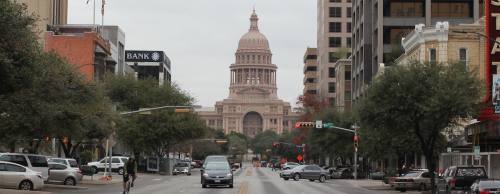When the Texas Legislature convenes Jan. 8, the state’s school finance system will be one of the major items lawmakers will have to tackle.
The Legislature was tasked in 2017 with making recommendations for improvements to the existing school finance system through the newly created Texas Commission on Public School Finance, according to the Texas Education Agency.
A report released by the commission Dec. 31 provides a slew of recommendations for the Legislature to consider this year, ranging from a $100,000 teacher salary to providing additional instructional days for disadvantaged learners. It also states that because the school funding system is outdated and unaligned with the needs of students today, the state’s future workforce and economy are at risk if changes are not made. For example, less than 30 percent of graduates today achieve a post-secondary credential six years following high school graduation, according to the report.
Therefore, the committee, which is composed of state legislators and school district administrators, is suggesting investing money in more specific, data-driven strategies to improve educational outcomes in the state.
Here are a few recommendations and takeaways from the report:
Provide a pathway to a $100,000 teacher salary
A pathway to a $100,000 salary for the most effective teachers would be created for participating districts in an effort to minimize turnover among teachers. Today, 1 in 6 Texas teachers leave their district annually, according to the report. Districts would have to implement an evaluation system to determine who would be considered an effective educator, according to the recommendation. The larger salary would help keep effective educators in the classroom and incentivize them to teach at challenged campuses, according to the report. Funding would start in 2019-20 school year at $100 million per biennium and be increased in phases to grow an additional $100 million each biennium for 10 years.
Create an optional program to offer 30 additional school days for students in pre-K through fifth grade
The committee is recommending the state create an extended-year incentive program to provide up to 30 additional days of instruction for students in pre-K through fifth grade based on proficiency. The program would also provide additional money to teachers through additional salary and would assist with child care during the summer, according to the report. The estimated cost for such a program is $50 million, according to the report.
Establish more specific statewide goals for the Texas education system
By 2030, 60 percent of jobs will require a post-secondary education or career certification after high school, according to the report. Therefore, the commission is recommending at least 60 percent of all students hit the state’s “meets standard” requirement for third-grade reading. It is also recommending at least 60 percent of all high school seniors graduate without the need for remediation and achieve an industry-accepted certificate that will earn them a living wage, or enroll in the military or post-secondary education. To achieve this, the report suggests several options, two of which include additional funding for every third-grader achieving “met standard” in reading and having long-term goals related to these metrics developed by a local board, which will provide data at the campus and district level.
Create strategies to slow property tax and recapture growth
Over the past several years, the amount of funding for Texas schools from state dollars has been on the decline, while money from recapture and local property taxpayers has increased. Recapture is often referred to as "Robin Hood" because it sends money from property-wealthy districts to property-poor districts. The committee is bringing forward three proposals on this topic, which include the following:
• Gov. Greg Abbott released in December a property tax and recapture reform plan, which proposes compressing districts’ Tier I tax rates as local property tax values rise to slow the growth of local property tax bills. If property tax levy increases are capped at 2.5 percent annually, the state can prevent more of a reduction in the state share of funding and slow recapture growth.
• Use future recapture growth as a revenue source to fund statewide compression of tax rates. This proposal would prevent roughly $600 million in annual recapture growth by 2023 and would reduce Tier I tax rates by $0.07 over four years, according to the report.
• Share recapture dollars with school districts, taxpayers and the state of Texas. However, the exact percentage for each group still needs further research, according to the report.
Expand the career and technology allotment to reach younger students
The state’s career and technology, or CTE, funding allotment only applies to high school courses today. Therefore, the committee is recommending the allotment be expanded to include CTE courses taught in sixth through eighth grade. Providing more CTE options to younger students would reduce the cost of post-secondary school and improve student readiness, according to the report. The estimated cost is $20 million.
How can the state pay for these recommendations?
The state is expecting to receive additional funding from existing revenue streams such as sales tax and severance tax for the next two years, according to the report. It also suggests various changes to the existing finance system, such as changes in allotments and formula weights. However, the committee is recommending the Legislature look at other options to ensure there is enough funding long term, such as redirecting a portion of severance taxes designated for the Rainy Day Fund—also known as the Economic Stabilization Fund that a portion of oil and gas production taxes go into—and expanding the sales tax base to include internet sales associated with vendors without a physical presence in Texas. In the event those revenue streams are not enough, the committee discussed other options, such as increasing the motor fuel tax by 10 cents for gas and diesel fuel and increasing the alcoholic beverage tax by 50 percent as other potential ideas.
To view the entire report,
click here.





